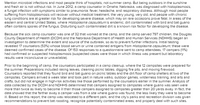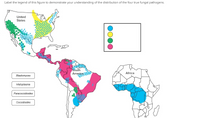
Body Structures & Functions Updated
13th Edition
ISBN: 9780357191606
Author: Scott
Publisher: Cengage
expand_more
expand_more
format_list_bulleted
Concept explainers
Question

Transcribed Image Text:Mention microbial infections and most people think of hospitals, not summer camp. But being outdoors in the sunshine
and fresh air is not without risk. In June 2012, a camp counselor in Omaha, Nebraska, was diagnosed with histoplasmosis,
a fungal infection with symptoms similar to pneumonia: fever, headache, and respiratory distress. Although most people
suffering from histoplasmosis will recover without medical treatment, the very young, very old, and people with chronic
lung conditions are at greater risk for developing severe disease, which may on rare occasions prove fatal. In areas of the
eastern and central United States, where Histoplasma capsulatum is endemic, dirt contaminated with bird and bat guano
often contains spores of the fungus. Disturbing such contaminated dirt is a known risk factor for developing the disease.
Because the sick camp counselor was one of 32 that worked at the camp, and the camp served 797 children, the Douglas
County Department of Health (DCDH) and the Nebraska Department of Health and Human Services (NDHHS) began an
investigation to determine the extent and source of the outbreak, so as to prevent further infections. Initial testing
revealed 17 counselors (53%) whose blood serum or urine contained antigens from Histoplasma capsulatum, these were
deemed confirmed cases of the disease. Of 153 responses to a questionnaire sent to camp attendees, 17 campers (11%)
had confirmed or suspected histoplasmosis (suspected cases were those in which illness was present but laboratory
results were inconclusive or unavailable).
Prior to the beginning of camp, the counselors participated in a camp cleanup, where the 12 campsites were prepared for
the summer. Preparations included raking leaves, cleaning picnic tables, digging fire pits, and moving firewood.
Counselors reported that they found bird and bat guano on picnic tables and the dirt floor of camp shelters at two of the
campsites. Campers arrived a week later and took part in nature walks, outdoor games, wilderness training, and arts and
crafts, but did not engage in high-risk activities like those performed by the counselors earlier in the summer. Analysis of
data collected by the DCDH and NDHHS determined that campers assigned to campsites where guano was seen were
more than twice as likely to become ill than those campers assigned to campsites greater than 20 yards away. In fact, the
data showed that the farther away a camper was from a site where guano was found, the less likely they were to become
ill. Based on this report, the camp was relocated to a different park, and the city's parks and recreation division was given
recommendations to prevent bat roosting, recognize potentially contaminated areas, and properly deal with such sites.

Transcribed Image Text:Label the legend of this figure to demonstrate your understanding of the distribution of the four true fungal pathogens.
United
States
South
America
Africa
Blastomyces
Histoplasma
Paracoccidioides
Coccidioides
Expert Solution
This question has been solved!
Explore an expertly crafted, step-by-step solution for a thorough understanding of key concepts.
This is a popular solution
Trending nowThis is a popular solution!
Step by stepSolved in 3 steps

Knowledge Booster
Learn more about
Need a deep-dive on the concept behind this application? Look no further. Learn more about this topic, biology and related others by exploring similar questions and additional content below.Similar questions
- The man pictured in Figure 4.17 wears skin ornaments applied by piercing. Among other functions, the skin is a barrier to potentially dangerous bacteria, and some people object to extensive body piercing on the grounds that it opens the door to infections. Explain why you do or dont agree with this objection. Figure 4.17 This young man has chosen to undergo multiple body piercings.arrow_forward______ are barriers to pathogens at body surfaces. a. Intact skin and mucous membranes b. Tears, saliva, and gastric fluid c. Resident bacteria d. All are correctarrow_forwardWhich species does not cause human disease? a. Toxoplasma gondii b. Entamoeba histolytica c. Dictyostelium discoideum d. Trichomonas vaginalisarrow_forward
- Why can’t dogs catch the measles?arrow_forwardWhy can superficial mycoses in humans lead to bacterial infections?arrow_forwardThere have been recurring cases of mad-cow disease in the United Kingdom since the mid-1990s. Mad-cow disease is caused by a prion, an infectious particle that consists only of protein. In 1986, the media began reporting that cows all over England were dying from a mysterious disease. Initially, there was little interest in determining whether humans could be affected. For 10 years, the British government maintained that this unusual disease could not be transmitted to humans. However, in March 1996, the government did an about-face and announced that bovine spongiform encephalopathy (BSE), commonly known as mad-cow disease, can be transmitted to humans, where it is known as variant Creutzfeldt-Jakob disease (vCJD). As in cows, this disease eats away at the nervous system, destroying the brain and essentially turning it into a spongelike structure filled with holes. Victims experience dementia; confusion; loss of speech, sight, and hearing; convulsions; coma; and finally death. Prion diseases are always fatal, and there is no treatment. Precautionary measures taken in Britain to prevent this disease in humans may have begun too late. Many of the victims contracted it over a decade earlier, when the BSE epidemic began, and the incubation period is long (vCJD has an incubation period of 10 to 40 years). A recent study concluded that 1 in 2,000 people in Great Britain carry the abnormally folded protein that causes vCJD. In spite of these numbers, the death rate from vCJD remains low. It is not clear whether this means that the incubation period for the disease is much longer than previously thought, or whether they may never develop the disease. What measures have been taken to stop BSE?arrow_forward
- There have been recurring cases of mad-cow disease in the United Kingdom since the mid-1990s. Mad-cow disease is caused by a prion, an infectious particle that consists only of protein. In 1986, the media began reporting that cows all over England were dying from a mysterious disease. Initially, there was little interest in determining whether humans could be affected. For 10 years, the British government maintained that this unusual disease could not be transmitted to humans. However, in March 1996, the government did an about-face and announced that bovine spongiform encephalopathy (BSE), commonly known as mad-cow disease, can be transmitted to humans, where it is known as variant Creutzfeldt-Jakob disease (vCJD). As in cows, this disease eats away at the nervous system, destroying the brain and essentially turning it into a spongelike structure filled with holes. Victims experience dementia; confusion; loss of speech, sight, and hearing; convulsions; coma; and finally death. Prion diseases are always fatal, and there is no treatment. Precautionary measures taken in Britain to prevent this disease in humans may have begun too late. Many of the victims contracted it over a decade earlier, when the BSE epidemic began, and the incubation period is long (vCJD has an incubation period of 10 to 40 years). A recent study concluded that 1 in 2,000 people in Great Britain carry the abnormally folded protein that causes vCJD. In spite of these numbers, the death rate from vCJD remains low. It is not clear whether this means that the incubation period for the disease is much longer than previously thought, or whether they may never develop the disease. If you were traveling in Europe, would you eat beef? Give sound reasons why or why not.arrow_forwardWhich of these diseases is caused by bacteria? a. flu b. AIDS c. measles d. syphilisarrow_forwardBacilli, which are rod-shaped, spore-forming bacteria, cause _____________________. Lyme disease measles rubella anthraxarrow_forward
- Which of the following is a barrier against pathogens provided by the skin? high pH mucus tears desiccationarrow_forwardWhat type of chronic lung disease is caused by a Mycobacterium? asthma emphysema tuberculosis leprosyarrow_forwardRobert Koch (a) proposed a set of guidelines to demonstrate that a specific pathogen causes specific disease symptoms (b) discovered Helicobacter (c) showed that biofilms consist of microorganisms (d) proposed a hypothesis for antibiotic resistance (e) demonstrated that people can be stimulated to develop immunity to diseasearrow_forward
arrow_back_ios
SEE MORE QUESTIONS
arrow_forward_ios
Recommended textbooks for you
 Medical Terminology for Health Professions, Spira...Health & NutritionISBN:9781305634350Author:Ann Ehrlich, Carol L. Schroeder, Laura Ehrlich, Katrina A. SchroederPublisher:Cengage Learning
Medical Terminology for Health Professions, Spira...Health & NutritionISBN:9781305634350Author:Ann Ehrlich, Carol L. Schroeder, Laura Ehrlich, Katrina A. SchroederPublisher:Cengage Learning Microbiology for Surgical Technologists (MindTap ...BiologyISBN:9781111306663Author:Margaret Rodriguez, Paul PricePublisher:Cengage Learning
Microbiology for Surgical Technologists (MindTap ...BiologyISBN:9781111306663Author:Margaret Rodriguez, Paul PricePublisher:Cengage Learning Biology 2eBiologyISBN:9781947172517Author:Matthew Douglas, Jung Choi, Mary Ann ClarkPublisher:OpenStax
Biology 2eBiologyISBN:9781947172517Author:Matthew Douglas, Jung Choi, Mary Ann ClarkPublisher:OpenStax Human Biology (MindTap Course List)BiologyISBN:9781305112100Author:Cecie Starr, Beverly McMillanPublisher:Cengage Learning
Human Biology (MindTap Course List)BiologyISBN:9781305112100Author:Cecie Starr, Beverly McMillanPublisher:Cengage Learning



Medical Terminology for Health Professions, Spira...
Health & Nutrition
ISBN:9781305634350
Author:Ann Ehrlich, Carol L. Schroeder, Laura Ehrlich, Katrina A. Schroeder
Publisher:Cengage Learning

Microbiology for Surgical Technologists (MindTap ...
Biology
ISBN:9781111306663
Author:Margaret Rodriguez, Paul Price
Publisher:Cengage Learning

Biology 2e
Biology
ISBN:9781947172517
Author:Matthew Douglas, Jung Choi, Mary Ann Clark
Publisher:OpenStax

Human Biology (MindTap Course List)
Biology
ISBN:9781305112100
Author:Cecie Starr, Beverly McMillan
Publisher:Cengage Learning